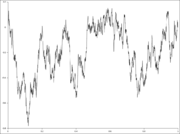
Brownian bridge
Encyclopedia

Stochastic process
In probability theory, a stochastic process , or sometimes random process, is the counterpart to a deterministic process...
B(t) whose probability distribution
Probability distribution
In probability theory, a probability mass, probability density, or probability distribution is a function that describes the probability of a random variable taking certain values....
is the conditional probability distribution of a Wiener process
Wiener process
In mathematics, the Wiener process is a continuous-time stochastic process named in honor of Norbert Wiener. It is often called standard Brownian motion, after Robert Brown...
W(t) (a mathematical model of Brownian motion
Brownian motion
Brownian motion or pedesis is the presumably random drifting of particles suspended in a fluid or the mathematical model used to describe such random movements, which is often called a particle theory.The mathematical model of Brownian motion has several real-world applications...
) given the condition that B(0) = B(1) = 0.
The expected value of the bridge is zero, with variance t(1 − t), implying that the most uncertainty is in the middle of the bridge, with zero uncertainty at the nodes. The covariance
Covariance
In probability theory and statistics, covariance is a measure of how much two variables change together. Variance is a special case of the covariance when the two variables are identical.- Definition :...
of B(s) and B(t) is s(1 − t) if s < t.
The increments in a Brownian bridge are not independent.
Relation to other stochastic processes
If W(t) is a standard Wiener process (i.e., for t ≥ 0, W(t) is normally distributed with expected value 0 and variance t, and the increments are stationary and independentLévy process
In probability theory, a Lévy process, named after the French mathematician Paul Lévy, is any continuous-time stochastic process that starts at 0, admits càdlàg modification and has "stationary independent increments" — this phrase will be explained below...
), then
is a Brownian bridge.
Conversely, if B(t) is a Brownian bridge and Z is a standard normal random variable, then the process
is a Wiener process for t ∈ [0, 1]. More generally, a Wiener process W(t) for t ∈ [0, T] can be decomposed into
Another representation of the Brownian bridge based on the Brownian motion is, for t ∈ [0, 1]
Conversely, for t ∈ [0, ∞]
The Brownian bridge may also be represented as a Fourier series with stochastic coefficients, as
where
 are independent identically distributed standard normal random variables (see the Karhunen–Loève theorem).
are independent identically distributed standard normal random variables (see the Karhunen–Loève theorem).A Brownian bridge is the result of Donsker's theorem
Donsker's theorem
In probability theory, Donsker's theorem, named after M. D. Donsker, identifies a certain stochastic process as a limit of empirical processes. It is sometimes called the functional central limit theorem....
in the area of empirical process
Empirical process
The study of empirical processes is a branch of mathematical statistics and a sub-area of probability theory. It is a generalization of the central limit theorem for empirical measures...
es. It is also used in the Kolmogorov–Smirnov test in the area of statistical inference
Statistical inference
In statistics, statistical inference is the process of drawing conclusions from data that are subject to random variation, for example, observational errors or sampling variation...
.
Intuitive remarks
A standard Wiener process satisfies W(0) = 0 and is therefore "tied down" to the origin, but other points are not restricted. In a Brownian bridge process on the other hand, not only is B(0) = 0 but we also require that B(1) = 0, that is the process is "tied down" at t = 1 as well. Just as a literal bridge is supported by pylons at both ends, a Brownian Bridge is required to satisfy conditions at both ends of the interval [0,1]. (In a slight generalization, one sometimes requires B(t1) = a and B(t2) = b where t1, t2, a and b are known constants.)Suppose we have generated a number of points W(0), W(1), W(2), W(3), etc. of a Wiener process path by computer simulation. It is now desired to fill in additional points in the interval [0,1], that is to interpolate between the already generated points W(0) and W(1). The solution is to use a Brownian bridge that is required to go through the values W(0) and W(1).
General case
For the general case when B(t1) = a and B(t2) = b, the distribution of B at time t ∈ (t1, t2) is normal, with meanExpected value
In probability theory, the expected value of a random variable is the weighted average of all possible values that this random variable can take on...

and variance
Variance
In probability theory and statistics, the variance is a measure of how far a set of numbers is spread out. It is one of several descriptors of a probability distribution, describing how far the numbers lie from the mean . In particular, the variance is one of the moments of a distribution...








